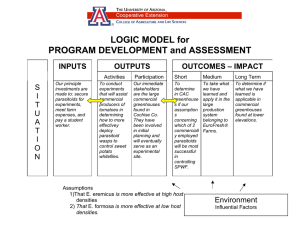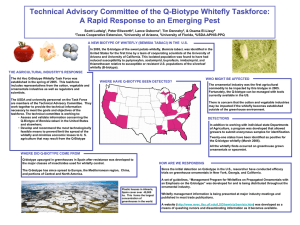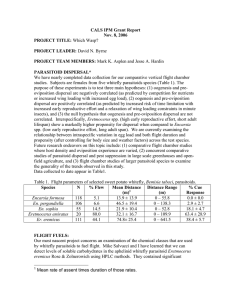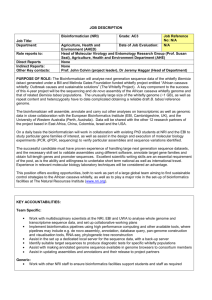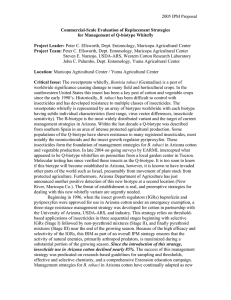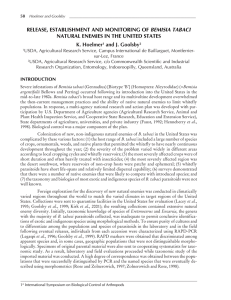Eretmocerus eremicus Control of Sweet Potato Whiteflies Infesting Melons
advertisement
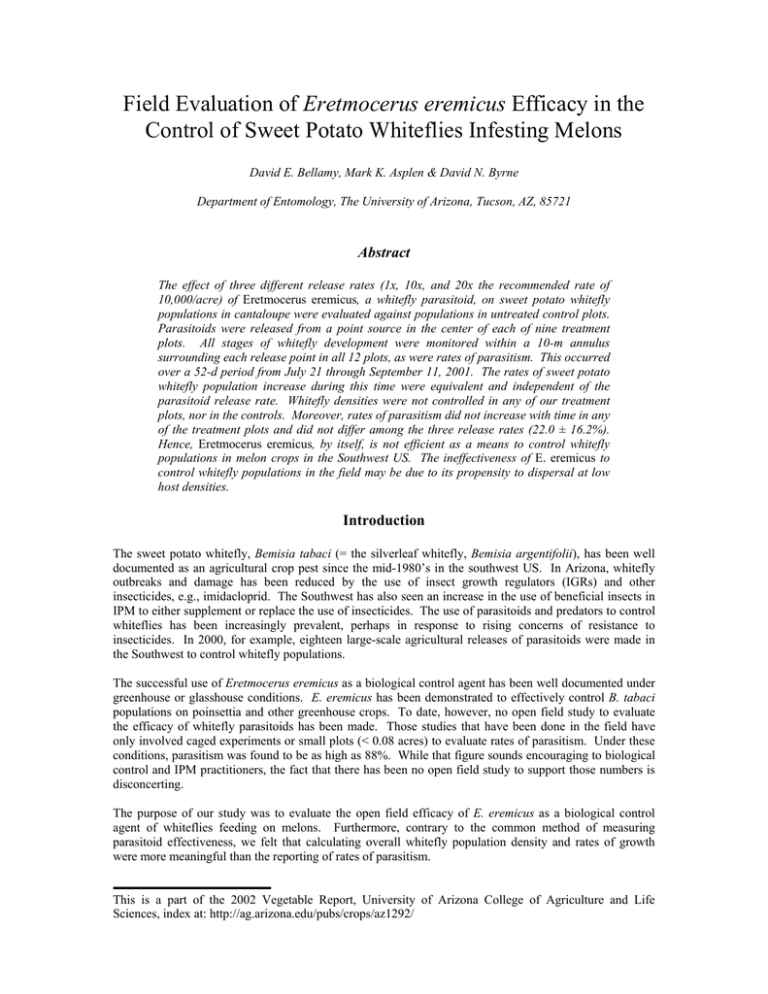
Field Evaluation of Eretmocerus eremicus Efficacy in the Control of Sweet Potato Whiteflies Infesting Melons David E. Bellamy, Mark K. Asplen & David N. Byrne Department of Entomology, The University of Arizona, Tucson, AZ, 85721 Abstract The effect of three different release rates (1x, 10x, and 20x the recommended rate of 10,000/acre) of Eretmocerus eremicus, a whitefly parasitoid, on sweet potato whitefly populations in cantaloupe were evaluated against populations in untreated control plots. Parasitoids were released from a point source in the center of each of nine treatment plots. All stages of whitefly development were monitored within a 10-m annulus surrounding each release point in all 12 plots, as were rates of parasitism. This occurred over a 52-d period from July 21 through September 11, 2001. The rates of sweet potato whitefly population increase during this time were equivalent and independent of the parasitoid release rate. Whitefly densities were not controlled in any of our treatment plots, nor in the controls. Moreover, rates of parasitism did not increase with time in any of the treatment plots and did not differ among the three release rates (22.0 ± 16.2%). Hence, Eretmocerus eremicus, by itself, is not efficient as a means to control whitefly populations in melon crops in the Southwest US. The ineffectiveness of E. eremicus to control whitefly populations in the field may be due to its propensity to dispersal at low host densities. Introduction The sweet potato whitefly, Bemisia tabaci (= the silverleaf whitefly, Bemisia argentifolii), has been well documented as an agricultural crop pest since the mid-1980’s in the southwest US. In Arizona, whitefly outbreaks and damage has been reduced by the use of insect growth regulators (IGRs) and other insecticides, e.g., imidacloprid. The Southwest has also seen an increase in the use of beneficial insects in IPM to either supplement or replace the use of insecticides. The use of parasitoids and predators to control whiteflies has been increasingly prevalent, perhaps in response to rising concerns of resistance to insecticides. In 2000, for example, eighteen large-scale agricultural releases of parasitoids were made in the Southwest to control whitefly populations. The successful use of Eretmocerus eremicus as a biological control agent has been well documented under greenhouse or glasshouse conditions. E. eremicus has been demonstrated to effectively control B. tabaci populations on poinsettia and other greenhouse crops. To date, however, no open field study to evaluate the efficacy of whitefly parasitoids has been made. Those studies that have been done in the field have only involved caged experiments or small plots (< 0.08 acres) to evaluate rates of parasitism. Under these conditions, parasitism was found to be as high as 88%. While that figure sounds encouraging to biological control and IPM practitioners, the fact that there has been no open field study to support those numbers is disconcerting. The purpose of our study was to evaluate the open field efficacy of E. eremicus as a biological control agent of whiteflies feeding on melons. Furthermore, contrary to the common method of measuring parasitoid effectiveness, we felt that calculating overall whitefly population density and rates of growth were more meaningful than the reporting of rates of parasitism. This is a part of the 2002 Vegetable Report, University of Arizona College of Agriculture and Life Sciences, index at: http://ag.arizona.edu/pubs/crops/az1292/ Materials and Methods Eretmocerus eremicus were purchased from Novartis® Beneficials for Crop Management (NBCM; Oxnard, California). Upon delivery, parasitized whitefly nymphs were partitioned into nine 1.9-l plastic emergence containers. Three of the containers held 100,000 parasitized nymphs, three more held 50,000, and the remaining three held 5,000 each. Field studies were conducted at The University of Arizona’s Marana Agricultural Center. Twelve disjoint 0.5-acre plots (108 ft x 197 ft) were planted with cantaloupe Cucumis melo L. c.v. “Top Mark” on 28 June 2001. The plots were a minimum of 110 ft apart and separated by fallow ground. The center of each plot and a corresponding 33-ft annulus were marked with flags. The centers of the treatment plots would be the site of parasitoid releases, while the 33-ft annuli would designate the sampling area boundaries in all plots. Three of the plots were designated as controls and did not receive any parasitoid releases. Three plots were assigned to receive 5,000 wasps: within the range of release rates recommended by both NBCM (10,000+/acre) and the Biological Control Network (10,000/acre) for E. eremicus against B. tabaci. Three replicate plots were assigned to receive 50,000 wasps, or 10x the recommended release rate, and the remaining three plots were allocated to receive 100,000 wasps or 20x the recommended release rate. The three control plots were no nearer than 430 ft from the closest plot treated with parasitoids to reduce accidental infestation. Wasps were released in each of the nine treatment plots on 30 July, 13 August, and 03 September 2001 from emergence containers. Adult whitefly population levels were assessed every two weeks from 21 July through 11 September by removing all adults present on 10 5th true leaves, randomly selected from within the 33-ft annulus in each plot, with a vacuum handgun. Each sampled leaf was then collected. In the laboratory, surface area for each sampled leaf was measured. Adult B. tabaci densities were then calculated as adults/in2 of leaf area. Immature whitefly populations were concurrently assessed with adult populations by collecting 10 randomly chosen 8th true leaves from within the 33-ft annuli in each plot. This position was chosen because it represented the leaf that had the highest reported whitefly egg and nymphal, densities on cantaloupe. Each leaf was placed into a Ziplock® bag. Upon return, a 0.75-in2 leaf disk was removed from each leaf and placed topside- down in a petri dish plated with agar. All eggs, nymphs, and parasitized nymphs were counted on each leaf disk. Densities were calculated as eggs/in2, nymphs/in2 and parasitized nymphs/in2. Because whitefly densities and rates of parasitism are known to vary with leaf position, overall field populations and rates of parasitism were calculated using the proportions reported in 1999 by J.R. Gould and S.E. Naranjo for both E. eremicus and B. tabaci in field grown cantaloupe. To ensure the rates of parasitism were the result of E. eremicus, petri dishes containing punched leaf disks were kept for a maximum of 21 d. The agar used limited fungal and bacterial growth and maintained leaf quality during this time period. Pre-trial studies demonstrated that immature B. tabaci on punched leaves placed on this agar could successfully complete development through adult eclosion over an 21-d period and that the leaf quality would remain steady for 14 d before beginning to senesce. Leaf disks were examined every 3 d for emergence of either adult whiteflies or parasitoids. Emerged parasitoids were identified and, if identified as E. eremicus, used to calculate rates of parasitism. Results and Discussion During the time of the study, egg and immature B. tabaci population densities increased from a mean of 5.16/in2 on July 29 (range: 2.71/in2 – 7.93/in2) to 296.57/in2 (range: 186.28/in2 – 374.94/in2) on September 5 (Fig. 1). Immature population densities were considerably higher on September 5, our last sample date, increasing by 756% over the previous sample date. Analysis of adult whitefly counts shows that there was a similarly large rise in adult populations on August 12, 24 days earlier, which is comparable to the suggested developmental time of B. tabaci on cantaloupe of 21.4 d. The increase in adult whitefly population during our experiment appears to be responsible for the sharp late season immature population growth and is likely due to immigration from other neighboring crops. Whitefly population densities differed among the four treatments, with control plots (0x) supporting the lowest densities (Table 1). The densities in the control plots are believed to have been initially lower because of their lack of proximity to surrounding sources of whiteflies. The other treatment plots, however, were all adjacent to older cotton and melon crops allowing for larger initial whitefly densities. Despite the population differences between the controls and treatments, the rate of growth for all treatments was statistically the same (Fig. 1) regardless of the number of parasitoids released. Statistically, rates of parasitism remained relatively steady throughout the sampling period at 22.0 ± 16.2%. Parasitism appeared to increase during the second sampling week of August 7 with one of the three 10xtreatment plots reporting 80.2%. The rise in parasitism on this sample date was only significant in the 10x treatment, however, as rates on all subsequent sample dates declined and were equivalent to the other treatments. Rates of parasitism in the other treatments failed to show any increase in rates of parasitism during the entire study. Our results show that differing application densities do not affect rates of parasitism in cantaloupe within a 16.5-ft radius of the release point. This is contradictory to earlier studies involving E. eremicus attacking B. tabaci that show higher applications of parasitoid releases produce higher rates of parasitism. It is suggested that increased rates of parasitism limit or delay whitefly populations. These studies have been conducted on greenhouse plants, e.g., poinsettia, or in field cages in cotton where neither the immigration of whiteflies nor the emigration of parasitoids can occur. These closed systems appear well suited for biological control practices and have seen much success. However, in discontinuous or open landscapes, like those found in agricultural settings in the Southwest, the impact of parasitoid releases on the control of agricultural pests are rare. Our results indicate that releasing E. eremicus from a point source fails to impact B. tabaci population growth locally in open cantaloupe fields, irrespective of release density. Because previous programs have shown successful control of B. tabaci, the use of E. eremicus, as a biological control agent, should not be avoided. Further research on various release protocols and timing are, nevertheless, needed before an effective open field program appears feasible. 2.5 2 Log immature 1.5 1 0.5 0 -0.5 0 10 20 Number of days 30 40 Fig. 1. Mean rates of population increase of immature B. tabaci in cantaloupe over a 40-d period for 0x (bold), 1x (line), 10x (dashed line), and 20x (dotted line) recommended E. eremicus release rates. The rate of whitefly population growth is the same for all treatments regardless of the number of E. eremicus released. Treatments 0x, control 1x, 10,000/acre 10x, 100,000/acre 20x, 200,000/acre Eggs/in2 49.80 Nymphs/in2 Adults/in2 1.03 0.59 Rate of parasitism 17.43 98.59 1.70 0.69 17.21 74.04 2.08 0.96 27.95 87.27 2.68 1.51 26.39 Table 1. Mean estimated B. tabaci densities and rates of parasitism in cantaloupe over the entire experiment. Treatments indicate the application rates of E. eremicus compared to the recommended release rate.
